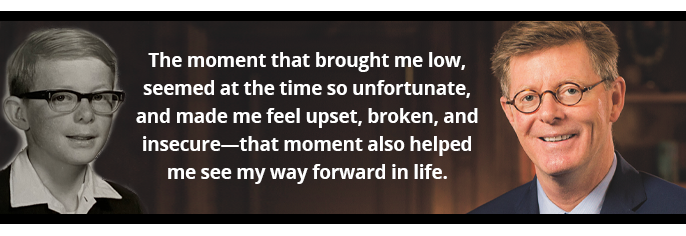It was one of the lowest moments in my childhood. Our fifth-grade class had been marched down to the school nurse’s office for routine eye examinations, and I was standing in front of the wall chart with a hand over one eye. I could only make out a single, big E at the top—the rest of the letters were blurred into a whirl of grayish shadow below, and all I could do was string together random guesses as to what they might be. For a kid who generally did well on tests, I knew I was failing this one badly. I somehow had been walking through life without realizing that my eyesight had taken a decided turn for the worse.
Things only got uglier—and I mean this quite literally—when that failed test naturally resulted in my being fitted with a pair of horn-rimmed glasses. They were the furthest thing from a fashion statement a ten-year-old could imagine. My only solace came from seeing my classmate Joe Voss, who had been swept up with me in that same nursing dragnet, show up at school sporting exactly the same eyeglasses. They must have been standard issue. Misery, as they say, loves company.
But those painfully unattractive glasses also brought me one of the most memorable aha! moments of my life. Suddenly the world had definition. It was so much brighter, more intense. On that unforgettable drive home after being fitted, I noticed that the trees lining the street had leaves—actual, distinct leaves, thousands of them, fluttering in the breeze. So dramatically sharp was the change, and so accustomed had I become to a blurry existence, that at first I could only tolerate wearing my glasses for a few minutes at a time.
To borrow a tired expression, I was seeing the world through new eyes.
 These moments are familiar to all of us, even those lucky few with perfect vision. The great essayist William Safire wrote that aha is “one of the great, unappreciated, and deliciously nuanced words in the English language,” showing up first in Chaucer and later in Hamlet and the King James Bible. It expresses the surprise and joy of discovery, of experiencing what had always been blurry as suddenly quite clear.
These moments are familiar to all of us, even those lucky few with perfect vision. The great essayist William Safire wrote that aha is “one of the great, unappreciated, and deliciously nuanced words in the English language,” showing up first in Chaucer and later in Hamlet and the King James Bible. It expresses the surprise and joy of discovery, of experiencing what had always been blurry as suddenly quite clear.
Indeed, these discoveries are at the heart of what we do as a university. We provide space and support for students, faculty, and staff to have their own aha! moments, to openly engage with diverse perspectives and freely express their own. We give alumni a platform for discovery throughout their lives through lifelong-learning initiatives and other innovative programming. We conduct vital research that serves our community and the world, work that in this uncertain time is perhaps best evidenced by the Duke visionaries who are leading the effort to find a vaccine and effective treatments for COVID-19.
Perhaps most important, we remain open to discovering new truths about ourselves and our own university. That openness has not only inspired innovation in our teaching and learning and our adaptation to the realities of the pandemic. It is also at the heart of our efforts to better understand the university’s history—including those chapters long blurred by misperception—and to find new clarity in our vision of an institution committed to promoting knowledge in service of society, countering systemic racism and myriad social, economic, and health inequities.
As I contemplate these opportunities for discovery, I am reminded that my first aha! moment came from that deeply unhappy trip to the nurse’s office. The moment that brought me low, seemed at the time so unfortunate, and made me feel upset, broken, and insecure—that moment also helped me see my way forward in life.
In that spirit, may we all hear the call to find the moments of wonder in these challenging months. For opportunities abound to see the world through fresh eyes—no glasses required.
Price is the tenth president of the university.
Share your comments
Have an account?
Sign in to commentNo Account?
Email the editor